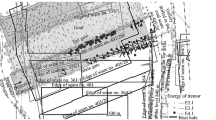Conclusions
-
1.
When constructing hydroelectric complexes with high dams under complex mining and geological conditions, the design and estimate documents must take into account expenditures related with high gradients of the roads and their narrowing by transportation tunnels and the inevitable drop in the productivity of excavators and dump trucks when excavating along a narrow loading front, and their drop in productivity in diggings with front faces, resulting from of the cyclic character of the operation. At such construction sites it is expedient to create special services for observing the behavior of the rock slopes of excavations and of gorges, to develop measures for safe methods of conducting the rock work, coordinating these activities, and excuting various mining operations in especially dangerous regions of the construction site.
-
2.
All rock excavations under the conditions of slopes more than 6–8 m high should be performed by smooth blasting, using a millisecond-delay detonator. The use of the smooth-blasting method permits excavating rock to any depth with prescribed slopes and configuration of the flanks, preserving the natural state of the rock in the slopes, and reducing appreciably the volume and labor consumption for trimming the slopes of deep excavations. The introduction of the smooth-blasting method should be preceded by a thorough working out of the blasting parameters with consideration of local geological conditions.
-
3.
A pronounced cutback in the consumption of labor for cleaning slopes of hanging stones, blocks, and rock wastes, and in preparing the rock foundation for concrete structures can be achieved by breaking away the slopes by a jet of water from a hydraulic giant at a pressure of 8–12 atm.
-
4.
When using excavators with buckets having a relatively large capacity (ÉKG-4, É-2503, etc.) for removing rock and when excavating severely jointed rock the use of short-hole perforatory drilling should not be used and can be permitted only in minimum volumes for finishing the base under concrete structures to a depth of 1–1.5m. The BMK and NKR percussive-rotary drilling rigs should be used for the main drilling operations.
Similar content being viewed by others
Additional information
See also the articles on the construction of the underground structures, Gidrotekhnicheskoe Stroitel’stvo, No. 3, 1967-Editor.
Translated from Gidrotekhnicheskoe Stroitel’stvo, No. 4, pp. 7–12, April, 1967.
Rights and permissions
About this article
Cite this article
Erakhtin, B.M. Rock work in the construction of the Chirkei Hydroelectric Power station. Hydrotechnical Construction 1, 305–313 (1967). https://doi.org/10.1007/BF02376182
Issue Date:
DOI: https://doi.org/10.1007/BF02376182




